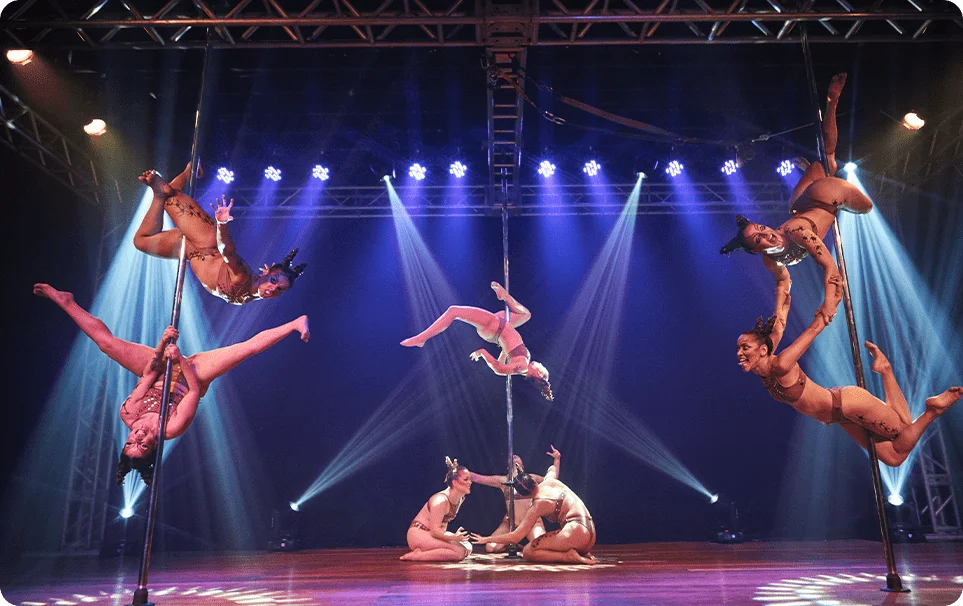The history of pole dance is fascinating and filled with transformations over the centuries. Today, this practice is widely recognized as an art form, a sport, and a physical exercise, but its roots are much older and more intriguing than one might imagine.
In this article, we will explore the origins of pole dance, its evolution over time, and how it has secured its prominent place in the modern world. Check it out!
The origins of pole dance: Across cultures and centuries
The history of pole dance is rich and diverse, with roots that span centuries and continents. Long before becoming the artistic and athletic practice we know today, pole dance served various purposes in different cultures, ranging from physical training to entertainment.
Mallakhamb: the acrobatic discipline of India
Mallakhamb is widely recognized as one of the earliest practices similar to pole dance. Originating over 800 years ago in India, this traditional sport used a wooden vertical pole as a tool for acrobatic training. Practitioners performed complex movements, showcasing strength, flexibility, and balance. Originally, Mallakhamb was used as a physical enhancement method for Kushti wrestlers, a form of Indian wrestling, and it is still practiced as a sport in schools and gyms across the country.
Chinese Pole: the acrobatic spectacle of China
Another ancient manifestation that influenced modern pole dance is the Chinese Pole, a classic element of Chinese circus performances. Artists used vertical metal poles with flexible coatings to execute highly complex moves, such as rapid climbs, spins, and jumps. With gravity-defying performances, the Chinese Pole was more than entertainment—it was a testament to the skill, precision, and discipline of the acrobats. This tradition remains preserved in contemporary circus shows.
The transition to the west
The transition of pole dance to the West began to take shape in the early 20th century. During traveling fairs in the United States and Europe, cabaret dancers and burlesque performers started incorporating vertical poles into their acts. These sensual performances were held in circus tents and bars, where the venue’s support columns became part of the stagecraft.
Over time, this approach evolved, moving beyond nighttime entertainment and starting to resemble the athletic practice we know today. This change was essential for pole dance to gain respect and recognition in other contexts, such as gyms and competitions.
The origin of pole dance, therefore, is a mosaic of traditions and cultural practices that, despite their differences, share a connection between the body and the vertical pole. Each of these manifestations contributed to shaping pole dance as an artistic and athletic expression, promoting values like strength, beauty, and discipline.
The transformation of pole dance over time
Pole dance has undergone significant evolution over the decades, transitioning from mere entertainment to becoming an artistic, athletic, and empowering activity.
The 80’s: the beginning of the fitness transition
In the 1980s, pole dance began to be introduced in dance studios and gyms, particularly in North America and Europe. During this period, the focus shifted from pure sensuality to the physical benefits of the practice. Pole dance started gaining recognition as a form of exercise, attracting individuals interested in improving their strength, flexibility, and body confidence.
Pioneering studios opened their doors, offering pole dance classes that combined technical movements with functional training. This approach helped break stereotypes, introducing pole dance as an accessible and empowering physical activity.
The 2000s: Global Recognition as Art and Sport
With the rise of the internet and the popularity of social media, pole dance gained global visibility in the 2000s. Videos of competitions and artistic performances began circulating widely, showcasing the strength, skill, and beauty of practitioners.
During this time, international organizations dedicated to regulating pole dance as a sport emerged, promoting competitions with technical and artistic standards. A significant milestone was the creation of the International Pole Sports Federation (IPSF), which works toward including pole dance in the Olympics. Disciplines like pole fitness, which emphasizes strength and technique, and artistic pole, which blends movements with emotional choreography, cemented pole dance as a respected art form and sport.
Pole dance today: inclusion and diversity
Today, pole dance is widely practiced in different contexts and for various purposes. Whether as a form of exercise, a performance art, or even therapy, pole dance welcomes people of all ages, genders, and skill levels. The practice promotes self-confidence, a connection with one’s body, and physical and mental health.
Moreover, pole dance has become a platform for discussions about inclusion and diversity. Practitioners from diverse cultural and social backgrounds find in pole dance a space for self-expression, overcoming limits, and challenging prejudice
Celebrating the history and future of pole dance
The history of pole dance is a journey of transformation, evolving from ancient traditions into a modern, inclusive practice. Gaia Pole is proud to be part of this movement, supporting championships, festivals, and events while offering equipment that not only enhances practitioners’ experiences but also contributes to the growth of the sport and art.
Our products are designed for maximum practicality and precision, featuring exclusive technologies like retractable poles and track-mounted poles, available only at Gaia. Additionally, the All-in-One Pole, considered the most complete in the world, is exclusive to Gaia.
If you want to learn more about our pole dance products, visit our website, and let’s build the future of this incredible practice together!
